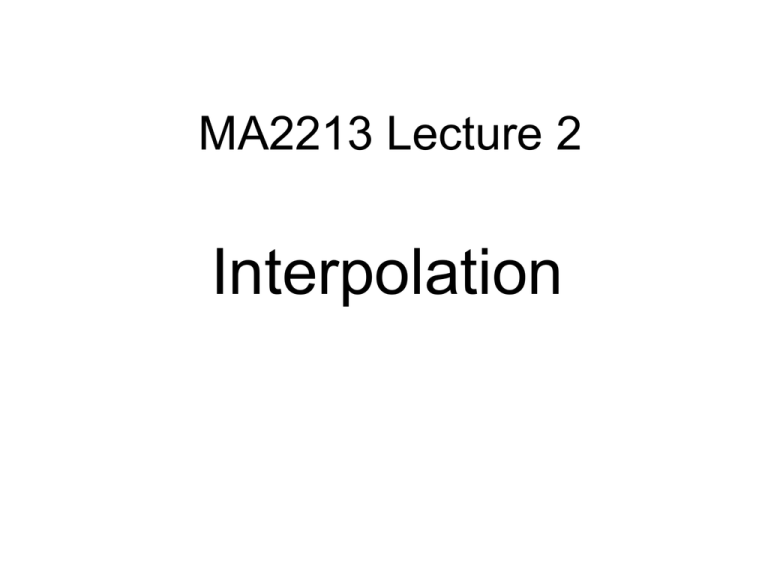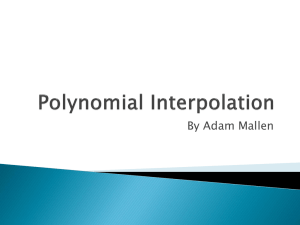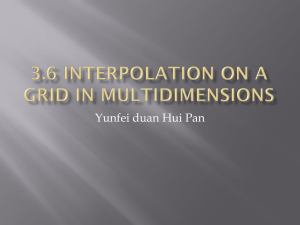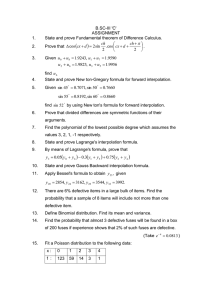L2_Interpolation
advertisement

MA2213 Lecture 2 Interpolation Introduction Problem : Find / evaluate a function P whose values are specified on some set S The specified values P ( x), x S may arise from measurements of a physical function f (ground height, air velocity-pressure-temperature) values of a mathematical function f (cos, log, exp, solution of a differential equation) Applications Medicine, Entertainement, Earth Sciences Computer Aided Design and Manufacturing Image Processing, Computer Graphics and Vision • Applications of interpolation and area display in EEG. – Applications of interpolation and area display in EEG. McGee FE Jr, Lee RG, Harris JA, Melby G, Bickford RG.MeSH Terms Automatic Data Processing* ... An Efficient Spline Basis For Multi-dimensional Applications ... File Format: PDF/Adobe Acrobat In many applications, bilinear interpolation is. used instead of cubic splines because of its simplicity in. implementation. When HDTV is realized, ... http://der.topo.auth.gr/DERMANIS/PDFs/Erice.pdf http://en.wikipedia.org/wiki/Linear_interpolation#Applications http://skagit.meas.ncsu.edu/~helena/gmslab/viz/sinter.html One Dimensional Case Given a sequence of numbers x1 x2 xn1 xn called nodes, and for each xk a second number y k we are looking for a function P so that P( xk ) yk , k 1,..., n A pair ( xk , yk ) is called a data point and P is called an interpolant for the data points. Example Suppose we have a table like this, which gives some values of an unknown function f. xk yk 0 1 2 3 4 5 6 0 0.8415 0.9093 0.1411 −0.7568 −0.9589 −0.2794 ( x3 , y3 ) ( x4 , y4 ) Plot of the data points as given in the table What value does the function have at, say, x = 2.5? Interpolation answers questions like this. Choosing a Method Plin (x) Linear Interpolation Ppol (x) Polynomial Interpolation There are many different interpolation methods, including linear and polynomial. Some of the concerns to take into account when choosing an appropriate method are: How accurate is the method? How expensive is it? How smooth is the interpolant? How many data points are needed? Linear Interpolation Formula for the linear interpolant on each of n-1 intervals Plin ( x) y k y k 1 y k xk 1 xk ( x xk ), x [ xk , xk 1 ] ( xk , yk ) ( xk 1 , yk 1 ) Remark If n > 2 then the interpolant is not a linear function, however, it is a piecewise linear function Linear Interpolation Error Definition The max error on the interval [ xk , xk 1 ] is Errork max | f ( x) Plin ( x) |, x [ xk , xk 1 ] Graph of ( xk , yk ) x f ( xk 1 , yk 1 ) Remark The error is clearly depends on f(x), not only of the interpolation points. Question Where does the max error occur ? Linear Interpolation Error The max error occurs at x I [ xk , xk 1 ] where a f ' ( x ) ( yk 1 yk ) /( xk 1 xk ) If f has 2 continuous derivatives on I then 2 1 " f ( x) P1 ( x) 2 f ( )( x x ) where P1 ( x) P1 f ( x ) a( x x ) is the deg 1 TP ( xk , yk ) x x ( xk 1 , yk 1 ) f ( x ) Plin ( x ) P1 ( xk ) f ( xk ) 12 f " ( k )( xk x ) 2 2 1 " f ( x ) Plin ( x ) P1 ( xk 1 ) f ( xk 1 ) 2 f ( k 1 )( xk 1 x ) | f ( x ) Plin ( x ) | ( xk 1 xk ) max | f ( x) |, x [ xk , xk 1 ] 1 8 2 " Linear Interpolation Basis Functions k 1 x1 x2 xk 1 xk x2 x 1 ( x) , x2 x1 x xk 1 k ( x) , xk xk 1 xk 1 x k ( x) , xk 1 xk x xn 1 n ( x) , xn xn 1 n xk 1 xn 1 x [ x1 , x2 ] x [ xk 1 , xk ], k 2,..., n 1 x [ xk , xk 1 ], k 2,..., n 1 x [ xn 1 , xn ] xn Linear Interpolation Basis Functions k 1 x1 n xk 1 xk x2 xk 1 k ( x j ) 1, jk k ( x j ) 0, jk xn 1 xn n Plin ( x) yk k ( x) k 1 Question Why is Plin (x) piecewise linear ? Polynomial Interpolation If Ppoly ( x) a0 a1 x an1 x and Ppoly ( xi ) yi , i 1,..., n 1 x1 a0 y1 a y 1 x 1 2 2 where V V 1 xn an 1 yn det V i i 2 then x n 1 xn n 1 1 n 1 2 x i 1 x x n n 1 j 1 j 0 unique solution Lagrange Basis Functions Lk x1 x2 xk 1 xk xk 1 xn 1 xn ( x x1 ) ( x xk 1 )( x xk 1 ) ( x xn ) Lk ( x) ( xk x1 ) ( xk xk 1 )( xk xk 1 ) ( xk xn ) Lk ( x j ) 1, j k , Lk ( x j ) 0, j k n Ppol ( x) yk Lk ( x) k 1 Question What is degree Ppol (x) ? Polynomial Interpolation Error Theorem 5.3 (page 121) If f has n continuous derivatives on [a,b] and a x1 xn b and Ppol (x) is the unique polynomial of degree n 1 that satisfies Ppol ( xi ) f ( xi ), i 1,..., n and x [ a, b] then c( x) [a, b] f ( x) Ppol ( xi ) ( x x1 ) ( x xn ) f (c( x)) 1 | f ( x ) P ( x ) | Corollary pol n ! M n | n ( x) | 1 n! M n max | f (n) (n) ( x) |, x [a, b] n ( x) ( x x1 ) ( x xn ) Polynomial Interpolation Error Example sin(.32)=.314567 , sin(.34)=.333487 , sin(.36) = .352274 , compute sin(.3367) Solution Using piecewise linear interpolation .34 .3367.32 sin(. 3367) .3367 . 314567 .32.34 .34.32 .333487 .33036520 sin(. 3367) .33037419 Error .33037419 .3303652 8.980e 006 1 2! M 2 ( x) 12 sin(. 34) ( x) 9.189e 006 Polynomial Interpolation Error Example sin(.32)=.314567 , sin(.34)=.333487 , sin(.36) = .352274 , compute sin(.3367) Solution using quadratic interploation x .3367, y sin( x) .33037419155563 x1 .32, x2 .34, x3 .36, yi sin( xi ), i 1,2,3 ( x x2 )( x x3 ) Pquad ( x) y1 0.33037439336976 ( x1 x2 )( x1 x3 ) Error P y 2.0181e 007 1 3! M 3 ( x) 16 cos(.32) ( x) 2.0315e 007 Divided Differences f ( x2 ) f ( x1 ) f [ x1 , x2 ] x2 x1 f [ x2 , x3 ] f [ x1 , x2 ] f [ x1 , x2 , x3 ] x3 x1 f [ x2 , , xn ] f [ x1 ,, xn 1 ] f [ x1 ,, xn ] xn x1 Theorem If x1 x2 xn and (n -1) f is continuous then c [ x1 , xn ] f [ x1 ,, xn ] ( n11) ! f ( n1) (c) Divided Differences Properties Invariance under permutation f [ x1 , x2 ] f [ x2 , x1 ] f [ x1 , x2 , x3 ] f [ x2 , x1 , x3 ] f [ x2 , x3 , x1 ] f [ x1 , x2 ,, xn ] f [ x2 , x1 ,, xn ] ' If f is continuous then (n -1) lim f [ x1 , x2 ] f ' ( x1 ) x 2 x1 Definition If f is continuous then (n -1) 1 we define f [ x1 ,, x1 ] ( n1) ! f ( x1 ) Divided Differences Computation For x1 x2 x3 x4 x1 f ( x1 ) x2 f ( x2 ) f [ x1 , x2 ] x3 f ( x3 ) f [ x2 , x3 ] f [ x , x , x ] 1 2 3 x4 f ( x4 ) f [ x3 , x4 ] f [ x , x , x ] f [ x , x , x , x ] 2 3 4 1 2 3 4 Question: How smooth must f be at repeated values of x ? Newton’s Interpolation Formula Let Pn1 ( x) denote the unique polynomial of degree < n that interpolates a function f at points x1 xn This means that Pn1 ( xi ) f ( xi ), i 1,..., n Then Pn1 ( x) f ( x1 ) ( x x1 )f [ x1 , x2 ] ( x x1 )( x x2 ) ( x xn1 )f [ x1 , x2 ,, xn ] Question How can the interpolant be computed recursively ‘point by point’ ? Natural Cubic Splines Problem Given x1 xn , y1 ,, yn 2 find a function s C ([ x1 , xn ]) such that s( xi ) yi , i 1,..., n and that minimizes x 2 [ s ( x )] dx among all functions that x satisfy the interpolatory constraint. Solution Unique function s described on pp.131-134 of Atkinson. Its restriction to each interval [ xi , xi 1 ], i 1,..., n 1 is a cubic polynomial determined by yi , yi 1 and parameters satisfying linear eqns. n 1 Natural Cubic Splines s ( x) ( x j x ) 3 M j 1 ( x x j 1 ) 3 M j 6 ( x j x j 1 ) ( x j x ) y j 1 ( x x j 1 ) y j x j x j 1 16 ( x j x j 1 )[( x j x) M j 1 ( x x j 1 ) M j ], x [ x j 1 , x j ] where M 1 M n 0 and x j x j 1 6 y j 1 y j x j 1 x j M j 1 x j 1 x j 1 3 y j y j 1 x j x j 1 Mj x j 1 x j 6 , j 2,..., n 1 Splines – are serious business ! M j 1 Homework Due at End of Lab 1 Question 1. Write and use a MATLAB program to solve problem 1. a. on page 77 using the bisection method. Make a plot of the errors as a function of the number of iterations. Question 2. Write and use a MATLAB program to find the real root of the polynomial (in the previous question) using Newton’s method. Make a plot of the errors as a function of the number of iterations. Suggested Reading: pages 117-159 Appendix B. Mathematical Formulas







